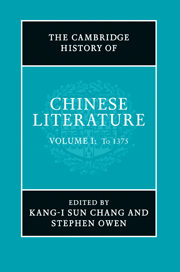Book contents
- Frontmatter
- Introduction
- 1 Early Chinese literature, beginnings through Western Han
- 2 From the Eastern Han through the Western Jin (ad 25–317)
- 3 From the Eastern Jin through the early Tang (317–649)
- 4 The cultural Tang (650–1020)
- 5 The Northern Song (1020–1126)
- 6 North and south: the twelfth and thirteenth centuries
- 7 Literature from the late Jin to the early Ming: ca 1230–ca 1375
- Select bibliography
- Glossary
- Index
- References
4 - The cultural Tang (650–1020)
Published online by Cambridge University Press: 28 May 2011
- Frontmatter
- Introduction
- 1 Early Chinese literature, beginnings through Western Han
- 2 From the Eastern Han through the Western Jin (ad 25–317)
- 3 From the Eastern Jin through the early Tang (317–649)
- 4 The cultural Tang (650–1020)
- 5 The Northern Song (1020–1126)
- 6 North and south: the twelfth and thirteenth centuries
- 7 Literature from the late Jin to the early Ming: ca 1230–ca 1375
- Select bibliography
- Glossary
- Index
- References
Summary
Overview
The cultural Tang does not correspond exactly with the political dynasty, founded in 618 and lasting until 907, by which time it had ceased to be a viable polity for a quarter of a century. We begin our cultural Tang with Empress Wu’s rise to power in the 650s and carry on into the first decades of the eleventh century, over half a century after the Song dynasty was established. This period is bounded on one side by the reign of Emperor Taizong (r. 627–649), the final phase of northern court culture and the full assimilation of the sophisticated legacy of the south. On the other side our period ends with the rise of the great political and cultural figures of the eleventh century, such as Fan Zhongyan (989–1052) and, most of all, Ouyang Xiu (1007–1072), writers who were to give Song literati culture its characteristic stamp.
Three hundred and seventy years is too long a span to constitute a meaningful literary-historical period, but comparison of literary culture at the beginning and end of this long era can bring out some of the fundamental changes that occurred. In the 650s, literature was centered almost entirely in the imperial court; by the end of the era literature had become the possession of an educated elite, who might serve in government, but whose cultural life was primarily outside the court.
Both before and during the Tang there were writers who used literature in a very personal way; it is not surprising that these were often the writers who continued to be read in later ages. At the same time, however, it is important to remember that literature was primarily a social practice, shared by an increasingly widening community. The Tang inherited a system of classical prose genres and poetic subgenres and extended it. Most of those prose genres and poetic subgenres were tied to specific occasions in life.
- Type
- Chapter
- Information
- The Cambridge History of Chinese Literature , pp. 286 - 380Publisher: Cambridge University PressPrint publication year: 2010
References
- 3
- Cited by

